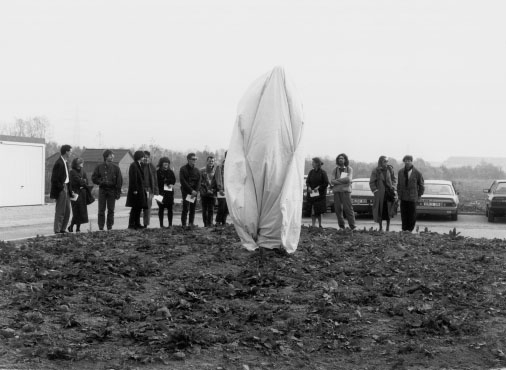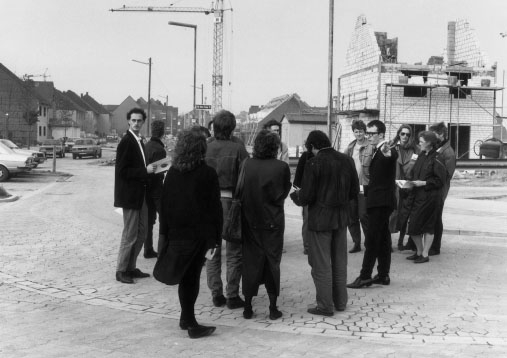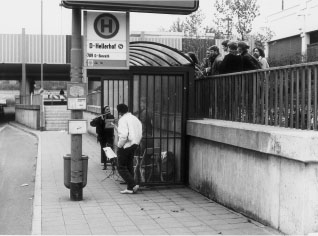Carl Theodors Garten in Düsseldorf-Hellerhof
4 – 26 October 1986
Düsseldorf-Hellerhof, Germany
Elements of the Performance:
– Six Sheets, labeled
– Program (32 pages)
– Entry tickets
Contributors:
Andreas Siekmann (speaker)
Beate Schmalbrock (flute)
Johannes Steinert (violin)
Ulrich Maiss (cello)
Jürgen Mester (speaker)
Robert Haiss (speaker)
In his tours of the Hellerhof district in Düsseldorf, Christian Philipp Müller spoke of aesthetics and good taste, integrating the planning of an Enlightenment garden into everyday suburban life. On eight weekend afternoons, he gave two-hour tours of a garden complex planned by Nicolas de Pigage in 1755 for the electoral prince, Carl Theodor. Originally intended for the site now occupied by the Hellerhof development, the palace and garden were, in fact, constructed in Benrath, a few kilometers to the north. Müller’s tours blended historic and modern urban planning, leading the way through Hellerhof, and using landmarks from the plans of 1755. In order to give permanent, visible expression to the connections between past and present, Müller proposed the creation of six public monuments. His listeners were to choose between two types of memorial — a bronze sculpture on a stone pedestal or a simple stone panel with a quotation. The monuments were dedicated to six philosophers and aestheticians, the intellectual fathers of the Enlightenment understanding of nature: Voltaire, Rousseau, Diderot, Goethe, Hirschfeld, and Montesquieu. All of these personages were positioned in Hellerhof as shrouded figures.
Müller announced his Saturday and Sunday tours through the city cultural office, local newspapers, and official gazettes. For each tour, he would pick up visitors from the main train station and drive them to the last commuter railway stop in the Hellerhof district where the tour would begin: “We find ourselves in the main building of Hellerhof station. From the domed hall, we enjoy a good view of the estate and the planned Rococo garden.”
Dressed in a tweed jacket with a bowtie amidst the modern development, Müller presented the fourteen most beautiful points of the palace garden as originally planned. An accompanying booklet mapped out each of these points with their function, designation, and present-day location. At each site, Müller provided information on the park elements originally planned there as well as historical personages. He also negotiated with municipal authorities regarding the installation of a painted metal panel to serve as a permanent visual record of the system of paths and waterways planned for the aristocratic garden in Hellerhof.
Müller’s tours gave insight into the prehistory of palace and garden planning in Hellerhof and connected the imaginary points of the periphery with real places in the modern district, at that time only a decade old. The proposed monuments included quotations from the shrouded figures, presenting the two alternatives of a realistic or a non-objective memorial. At a bus stop along the route of a projected garden path, Müller arranged a performance of music for violin, cello, and flute by court composer Johann Stamitz. Müller’s guests learned something about the waterworks of the garden and were informed that in 1748, Diderot was considered a “very dangerous person” by the police.
Essay by Sabeth Buchmann available here.
Essay by Frederik Leen available here.
Essay by Thomas Trummer available here.




